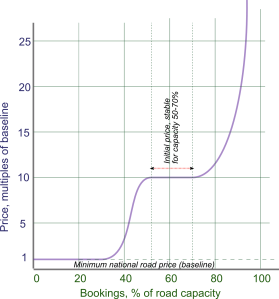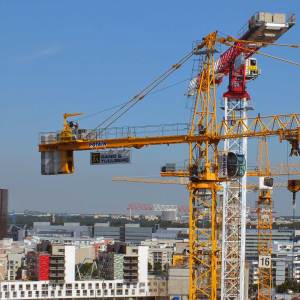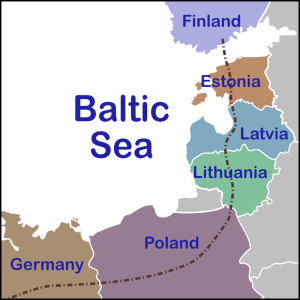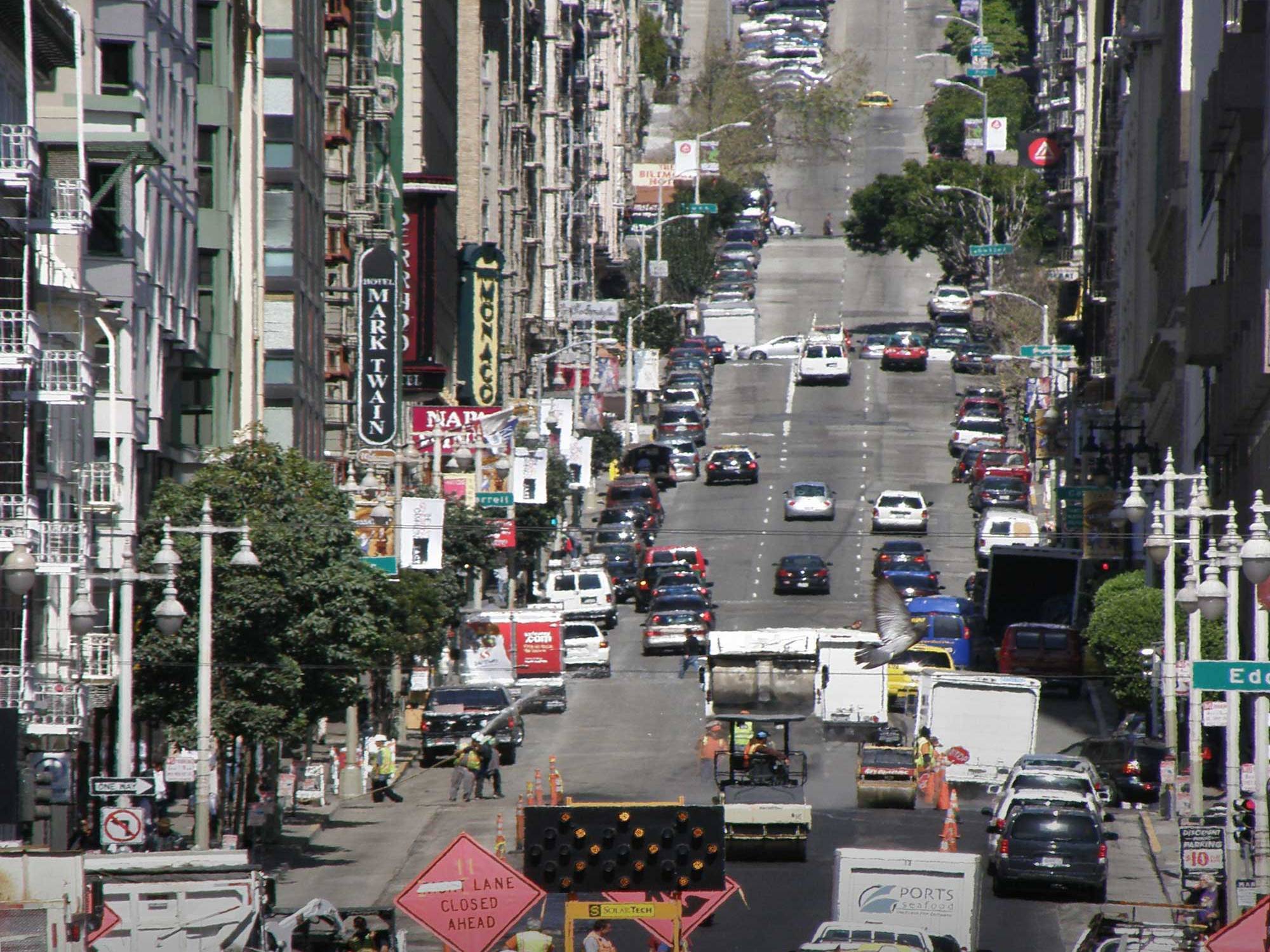Driven by the development of autonomous road vehicles, personal mobility and freight traffic will be transformed in the 2020s.
Alongside transport infrastructure, much other long-term social investment needs to be redesigned.
Quick points
- Systems soon compulsory
- Car ownership to continue
- Road pricing inevitable
- Freight deserts the rails
- Average road speeds fall
- Taxi operations expand
- Night travel by transleeper
- Urban densification curbed
- Rail Baltica now moribund
- Talsinki tunnel still doable
Sooner than you think
Spending on developing autonomous vehicles is growing. The first self-driving cars will be on the market within four years.
Driverless technology has extensive applications yet its components cost little. When it becomes available, the low price will overcome consumer doubts. This will pave the way to rapid acceptance.

The optional extra will become a must-have and then, soon after, a legal requirement on many roads.
In 2014 a Rand Corporation report [1] concluded that “automated vehicle technology” would reduce driver error and increase mobility. Smoother traffic flow might also cut travel time and raise fuel efficiency.
Alternatively, it said, congestion might increase, harming efficiency. The report added that less urban parking space would be needed, and certain occupations would become obsolete.
These scenarios can be refined by looking at the chain of events in which autonomous vehicles will probably appear on the roads. It soon becomes clear that the implications are far more extensive.
Shared vs. private
A self-driving car is part of several projects to develop technology for electric cars. In January 2015 Google announced that its car would be ready by 2020 [2] and that it was already in talks with major auto manufacturers.
In January 2016 General Motors, the largest US car maker, said it would invest $500 million to develop a fleet of autonomous vehicles that could be summoned on demand. Other manufacturers surely have plans for their own ecosystems. (This report is being written at the start of 2016.)
Some analysts concluded from GM’s strategy that autonomous driving will mark the end of the era of car ownership. Perhaps it is the beginning of the end but, in many markets, autonomous systems will first be a feature of cars offered for sale.
A key selling point is price. The heart of the system is not engineering hardware but computer software. Although extremely complex, it will not involve great material costs.
It will thus appeal even to drivers who do not expect to use it much. Smart phones caught on in the same way.
The next step after that will be to redesign roads so that they suit autonomous vehicles better. Traffic lights and roundabouts will be some of the features that disappear. But now we’re getting a bit ahead of ourselves.
Connectedness
Initially, a road will have to be precisely mapped [3] before Google’s cars can take over the job of driving and steering a path along it. But this is merely a development phase.
Autonomous cars can also add to the digital road map. When the map is sketchy, speeds may have to be restricted. Off the beaten track, a human driver will still sometimes be needed.[4]

But higher speeds become generally safer when each vehicle shares its position, speed, direction and intentions with the others. This is true even in a mixed environment of self-driving and manually driven cars,
Because a non-participating car is the weakest link, connectedness will become widely compulsory on busy roads.
In a few years, we will be horrified to recall the old days when we used to drive in blithe ignorance of what other cars on the road might suddenly do.
Connectedness will both facilitate and necessitate charges for road use, at least for optimising the routes of empty self-navigating cars.
A natural concomitant of self-driving is intelligent, reactive routing, so that the vehicle chooses routes and departure times that are less congested.
One way to rationalize and prioritize road journeys is to provide a money incentive. Market-based road pricing, previously too complex for most drivers, will become viable when software hides its mechanisms from users. [5]
Thinner flows
Road transport has none of the first and last mile problems of rail or aviation. But the ability to offer cheap door-to-door services has been compromised by the cost of employing the driver.
Hence the desire to pack a large number of people or a great volume of freight behind the driving seat. Autonomous systems will release road transport from aggregation, the need to convert thin traffic flows into thick ones.
Truck operators and bus companies will be able to focus on carrying goods and passengers from source to final destination immediately by the most direct route.
Freight vehicles and buses can be downsized. Smaller vehicles can be scheduled, routed and rerouted more flexibly throughout the day and the night.
(The disruptive effects on retailing are analysed in a separate report.)
In short, autonomous systems will expand the capacity of existing roads while making investments in new roads more worthwhile.
Patronage of other transport modes will decline fastest in countries with good highways. And good highways will become a more important precursor for economic growth.
Lower speeds
Because the human component of road transport requires recreation, rest and refuelling far more frequently than the vehicle, freight and passenger routes are determined largely by the distance that can be covered before a rest break or a new driver is needed.
This is an incentive for operations at the maximum safe speed. Drag force – air resistance – is the square of velocity, so fuel consumption can be reduced substantially by travelling more slowly. With no driver to consider, these savings can be exploited.
As fast acceleration and powerful propulsion become less important, clean but still relatively weak engines, powered by batteries, hydrogen or whatever, will become viable for commercial vehicles, not just private cars. Goodbye diesel.
So although the advent of autonomous vehicles inevitably means a shift of traffic towards the roads, more vehicle pollution is not inevitable.
However, the rising proportion of vehicles travelling well below the speed limit will require the construction of extra lanes on narrow but busy routes.
Overnight travel
Conventional public transport has never been as good as its advocates make out. Trains are expensively over-engineered. Buses are cheap but uncomfortable. Trams are heavy and slow. Air travel is efficient only when you are finally airborne.
And intermodal nodes are chaotic. For people with small children, big boxes or special needs, transfers can be horrible, especially in bad weather. No wonder door-to-door road vehicles are so popular.
With no driver required for most if not all of the journey, buses will be viable for longer distances. Trains will still have higher top speeds but the advantage shrinks when passengers are carried overnight.
Most people do little between 7 in the evening and 7 in the morning but eat, relax and sleep. For travel during this period we can expect to see new fleets of sleeper buses.
A few nightliners already exist but their design can be greatly improved. Once high passenger density ceases to be a priority, bus interiors can be subdivided into sleeping compartments.
Transverse sleepers could bring comfort, privacy and safety to overnight road travel. A night ride will often be more attractive than a daytime flight, because it will save useful time. Paris to Madrid is a suitable distance for an overnight ride.
Short-distance options

Depending on the price and comfort level, and the alternatives available, transleepers might also suit shorter journeys, such as Los Angeles to San Francisco. Depending on travellers’ preferences, road speed could be reduced to give more sleeping time.
Over very short distances, public transport vehicles will shrink. Fixed-route buses will generally be replaced by taxis of various sizes. Except in the densest urban areas, or where outdated bylaws prevent it, the distinction between buses and taxis will disappear.
Taxi driving is a doomed profession but fleets of autonomous vehicles for hire will still need people to maintain and manage them. Uber, Lyft and other ride-booking schemes are not the enemies of taxi operators but their only future.
Urban travel
Whether the ride is in a private car or one briefly hired from a fleet operator, the era of autonomous vehicles will bring a major advance in personal mobility.
Longer commutes become viable. Children can be enrolled in more distant schools. The aged and infirm will be less confined to their homes.
A home near the workplace or favourite school, or on public bus and train routes, becomes less important. Better mobility spells decentralisation.
Many will still prefer city living, especially when the streets cease to be clogged with parked vehicles. A self-driving car can be sent to park itself elsewhere.
Instead of wandering nearby streets in search of vacant kerb space, it will drive to a bay in a contract parking hall. City housing districts will need a smaller allocation of local parking space.
However, districts must have the road capacity to allow empty cars to leave and return again speedily. More efficient use of each autonomous car may curb idle journeys, but it won’t eliminate them.

In residential areas the road area under parked vehicles will be less than today. But households will still need roadside space for very short-term parking, where autonomous cars pick up and put down passengers and autonomous vans make home deliveries (see Retail Revolution).
The efficiency of housing districts would rise if households came to use shared car fleets. So would the efficiency of their capital invested in transport.
It’s worth remembering, however, that the car has traditionally been a symbol of individuality and a focus of personalization. This is unlikely to change overnight.
Political inertia may sustain very high-density developments dependent on rail, especially when ground has already been broken. For home owners, employers, shops and schools, however, real estate poorly served by roads will be a bad investment.
Tunnel vision
Autonomous vehicles will allow longer road tunnels. Automatic systems suffer none of the tedium and anxiety that afflict human drivers underground. In areas where land is expensive, roads will increasingly be boxed in.
But in long tunnels under the sea, rail will continue to reign. It is many times more expensive to build and operate a safe subsea road tunnel and, over long distances, entirely impracticable.
So the spread of autonomous road vehicles does not mean that the plans of Helsinki and Tallinn for a 100-km rail tunnel under the Baltic Sea between Finland and Estonia are invalidated. Only the timetable.

The Baltic tunnel has been envisaged as a continuation of a high-speed railroad, Rail Baltica, planned between Tallinn and Central Europe and due to be ready in the early 2020s. Tunnel construction would then start around 2025.
Autonomous vehicle technology makes it very unlikely that Rail Baltica can win back freight and passengers to the railways. The Baltic States wasted a decade bickering about the route of the line. Now the window of opportunity is closed.
A subsea rail tunnel can still play an important role, creating a fixed link for passengers and freight between Finland and Estonia. However, most onward travel and transport will be by road.
The tunnel should therefore be constructed for trains with a wide loading gauge to facilitate rapid loading and transport of cars and freight vehicles.There is no need to postpone tunnel construction till Rail Baltica connects Warsaw and Berlin.
[1] Anderson, James M., Nidhi Kalra, Karlyn D. Stanley, Paul Sorensen, Constantine Samaras and Oluwatobi A. Oluwatola. Autonomous Vehicle Technology: A Guide for Policymakers. Santa Monica, CA, USA: Rand Corporation, 2014.
[2] 14 January 2015: International Business Times
[3] 15 May 2014: The Atlantic
[4] Society of Automotive Engineers, Levels of Driving Automation, standard J3016, 2014
[5] Humphreys, Pat. Road Pricing by Tradable Slots. Helsinki, Finland: Nordic Communications Corporation, 2013.

One thought on “Mobility 2020”